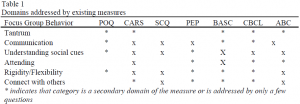Jaime Ballard and Dr. Mikle South, Psychology
Main Text
One in every 133 children in Utah has autism, a disorder characterized by poor social and communication skills (U.S. Autism Rate Soars Twentyfold in 20 Years, 2007). These rates are climbing across the nation. As more children are born with these disorders, schools and other educational facilities are struggling to develop proven programs to help these children function on a daily level. These programs, and the surveys designed to assess their effectiveness, often do not take into consideration which behaviors are most important to parents and teachers of children with autism. Parents and teachers are in the best position to report change in their child’s behaviors over time, and children make the most progress when parents participate in their treatment (Sattler and Hoge, 2006). Parents and teachers are in a prime position to determine which behaviors are most important to target for change during treatment. The purpose of our study was to determine which behaviors are most important to these caregivers, as well as to assess if existing survey measures address these behaviors.
We conducted group interviews with parents and teachers of children with autism. Nineteen parents and sixteen teachers participated in one of five interview groups where they discussed a) which behaviors of autism are most important and relevant in their daily lives and b) how relevant they find the domains from existing surveys of autism symptoms.
Focus groups were audio recorded and transcribed. The author then coded each transcript according to identified categories of behaviors. Analysis was facilitated by use of the NVivo 8 (Qualitative Solutions and Research International, Doncaster, Victoria, Australia) qualitative analysis software package.
Parents and teachers agreed on six behaviors were critical in their everyday lives: these behaviors included tantrums, communication, understanding social rules/cues, attending, rigidity, and connecting with others.
As these behaviors are the most important to parents and educators, they should be among the behaviors used to assess these children’s progress. For example, since tantrums are a critical behavior to parents and teachers, this behavior should be included in surveys used to measure progress in a program. A survey might ask, “How many times a week does this child have a tantrum,” and educators should expect this number to go down as the child participates in the program.
We compared the behaviors named by parents and educators to the behaviors assessed by the 7 most common survey measures used with preschoolers with autism. These measures include the Preschool Outcome Questionnaire, Childhood Autism Rating Scale, Social Communication Questionnaire, Psychoeducational Profile-3rd edition, Behavior Assessment System for Children, Autistic Behaviors Checklist, and Child Behavior Checklist.
None of the existing measures of treatment outcome adequately address all of the behaviors that are of top concern to parents and teachers (see Table 1). Of the six key areas, these measures most frequently fail to fully address tantrums. Other behaviors of importance, such as understanding social cues, are only briefly touched on by most measures.

Our research demonstrates that existing autism survey measures are more likely to focus on key features of autism, such as stereotyped movements, than on general maladaptive behaviors, such as tantruming, which are exaggerated in children with autism. However, the child’s functioning at school and home may be more affected by these general maladaptive behaviors such as tantrums. Two of the behaviors identified by parents and teachers, tantruming and attending, are not specifically autism related, but are clearly critical to parents and teachers of children with autism. Effective programs must implement survey measures that address these behaviors. The results of this study have been submitted to Autism: The International Journal of Research and Practice by Jaime Ballard, Dr. South, and Dr. Annelies DeBildt to facilitate the use of appropriate measures or the development of new survey measures if necessary.
It has been said that if you do not know where you are going, every road will get you nowhere. If program designers and treatment outcome evaluators do not know and address the behaviors are most important to parents and educators, no program can succeed in meeting their needs. A revision of the existing measures, or the design of new measures, is necessary to fully address the behaviors that are most important to parents and educators of preschoolers with autism.
References
- U.S. Autism Rate Soars Twentyfold in 20 Years; Utah’s Rate Ranks 3rd Highest in 14-State Study (2007, Feb. 8). U News Center. Retrieved March 13, 2009, from http://unews.utah.edu/p/?r=020807-2
- Sattler, JM, and Hoge, RD (2006) Assessment of children: Behavioral, social, and clinical foundations (5th ed.). San Diego, CA: Jerome M Sattler Publisher Inc.
